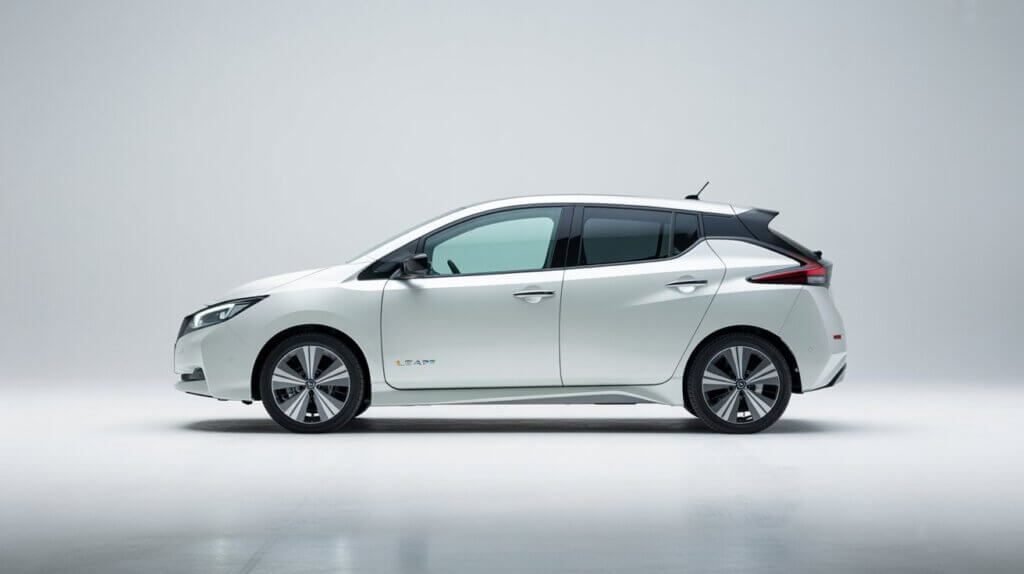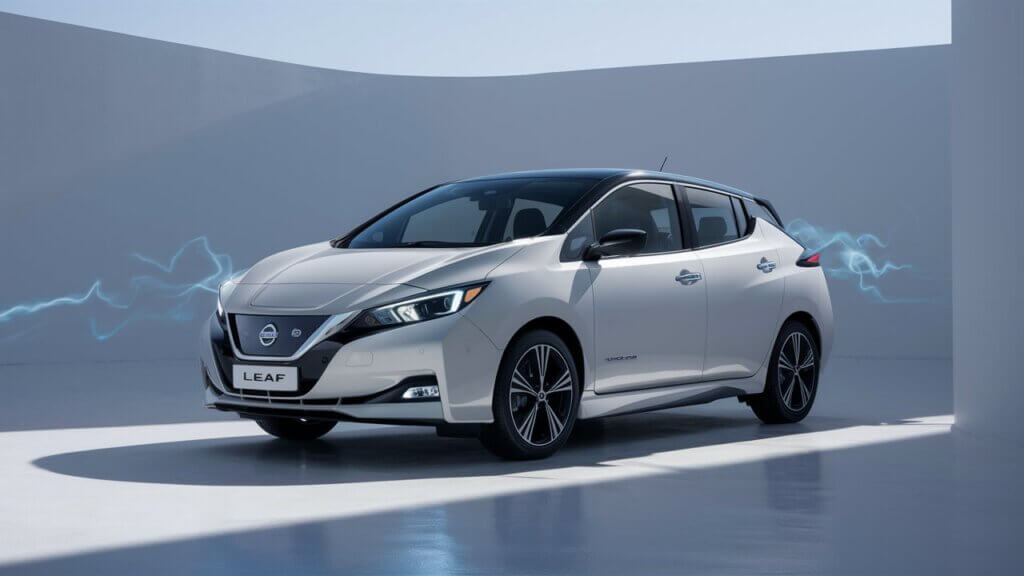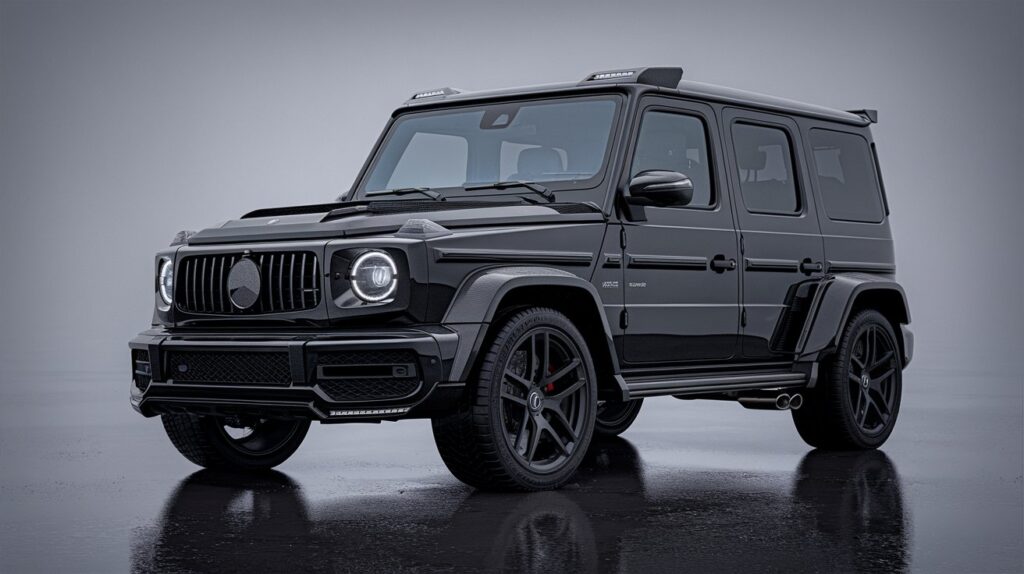The electric vehicle that started it all is back with a vengeance. The third-generation electric vehicle (EV) benefits from over 15 years of real-world insights gained through global sales of nearly 700,000 units. After years of watching competitors surge ahead with longer range and faster charging, Nissan has completely reimagined their pioneering EV for the 2026 model year (launching as a 2025 model). The result is a transformation so dramatic that longtime Leaf owners might not even recognize it.
Gone is the polarizing “jellybean” hatchback design that defined the first two generations. In its place stands a sleek, aerodynamically optimized crossover that looks more like a futuristic sports wagon than a traditional EV. But the real story isn’t just about looks – it’s about capability. With a new 75kWh battery delivering over 300 miles of range and charging speeds that finally compete with Tesla, the reinvented Leaf is ready to reclaim its position as America’s mainstream electric car.
Table of Contents
Complete Transformation: From Hatchback to High-Tech Crossover
The most obvious change is the dramatic styling overhaul. Nissan’s pioneering little EV has grown up, literally, adopting a fastback crossover silhouette that prioritizes aerodynamic efficiency over quirky charm. The new design achieves what Nissan claims is their most aerodynamically efficient production vehicle ever, with a drag coefficient that helps maximize that impressive range figure.
The crossover proportions serve a practical purpose beyond aesthetics. The taller ride height and increased ground clearance make the Leaf more appealing to American buyers who have increasingly abandoned sedans and hatchbacks for SUVs and crossovers. The elevated driving position provides better visibility, while the expanded cargo area addresses one of the original Leaf’s key weaknesses.

Design cues from Nissan’s Z sports car influence the front end, giving the Leaf a more aggressive, performance-oriented appearance. LED lighting signatures wrap around the vehicle, creating a distinctive nighttime presence that announces this isn’t your neighbor’s 2012 Leaf.
Revolutionary Range and Battery Technology
The headline specification is undoubtedly the range improvement. For the 2026 model year, the Nissan Leaf gets a radical makeover, becoming a sleek, curvy crossover with up to 303 miles of range. This represents a massive 43% improvement over the current Leaf SV Plus’s 212-mile EPA rating.
Two battery options will be available: a base 52kWh pack and the flagship 75kWh unit. The larger battery pairs with a 214-horsepower electric motor producing 261 lb-ft of torque, while the smaller pack uses a 174-horsepower motor. Both configurations maintain front-wheel drive, keeping costs down and maximizing efficiency.
Perhaps more importantly, Nissan has finally addressed the Leaf’s charging speed disadvantage. The new Leaf will be able to DC fast-charge at up to 150 kW, triple that of the old model, and Nissan says it’ll take 35 minutes to go from 10% to 80%. This brings the Leaf in line with competitors like the Chevrolet Bolt EUV and Hyundai Kona Electric.
The battery thermal management system has been completely redesigned with liquid cooling, eliminating the air-cooled system that limited charging speeds and caused degradation issues in hot climates. This represents perhaps the most significant technical improvement, as the original Leaf’s battery cooling limitations were a major source of owner complaints.
Advanced Technology and Features
Inside, the Leaf receives a comprehensive technology upgrade centered around dual displays. A 12.3-inch infotainment touchscreen handles navigation, entertainment, and vehicle settings, while a separate driver information display provides essential driving data. The interface design takes cues from Nissan’s Ariya flagship EV, offering a more premium experience than previous generations.
ProPilot Assist 2.1 comes standard on higher trims, providing enhanced semi-autonomous driving capabilities. The system can handle highway driving, including lane changes when prompted by the driver. For parking, the Leaf offers both automatic parallel and perpendicular parking assistance.
One significant charging infrastructure improvement is the addition of NACS (North American Charging Standard) compatibility. The revamped Leaf aims to compete in the crowded EV market, emphasizing affordability and range. This means Leaf owners will have access to Tesla’s Supercharger network, dramatically expanding fast-charging options across the country.
The interior space has grown along with the exterior dimensions. Rear passenger room improves significantly, while cargo capacity expands to accommodate the crossover body style. Material quality takes a step up, with available leather seating and soft-touch surfaces replacing the harder plastics of previous generations.
Performance and Driving Experience
While the Leaf has never been about straight-line speed, the new model delivers adequate performance for daily driving. The 214-horsepower top-spec motor provides brisk acceleration, though performance has actually suffered a bit, and the fastest new Leaf is fractionally slower than the outgoing model due to increased weight from the larger battery and crossover structure.

The elevated driving position and improved suspension tuning should provide a more confident, car-like driving experience compared to the sometimes twitchy feel of earlier Leafs. Nissan’s e-Pedal technology returns, allowing aggressive regenerative braking that can bring the vehicle to a complete stop in most situations.
Road noise has been a traditional Leaf weakness, but the new platform and improved sound deadening should address this concern. Early prototype drives suggest a notably quieter cabin, bringing the Leaf closer to luxury EV standards.
Trim Levels and Pricing Strategy
It’ll be available in four trims: S, S+, SV+, and Platinum+. The base S trim uses the smaller 52kWh battery, while the + models feature the 75kWh pack with extended range. This strategy mirrors successful competitors like the Chevrolet Bolt, offering an affordable entry point while providing premium options for buyers willing to pay more.
While official pricing hasn’t been announced, industry analysts expect the base model to start around $32,000, with the top-spec Platinum+ reaching approximately $42,000. This would position the Leaf competitively against the Bolt EUV, Hyundai Kona Electric, and Kia Niro EV.
Federal tax credits up to $7,500 could bring the effective starting price below $25,000, making the Leaf one of the most affordable long-range EVs available. For buyers prioritizing value over luxury, this pricing strategy could prove compelling.
Safety and Reliability Considerations
Nissan‘s Safety Shield 2.0 suite comes standard across all trim levels, including automatic emergency braking, blind spot monitoring, and rear cross-traffic alert. The new platform should provide improved crash protection compared to the aging previous-generation structure.
One advantage Nissan maintains is their extensive EV experience. With nearly 700,000 Leafs sold globally, the company has more real-world electric vehicle data than most competitors. This experience influenced the new thermal management system design and charging protocols.
The move to liquid-cooled batteries should dramatically improve long-term reliability and resale value. Previous-generation Leafs in hot climates often experienced significant battery degradation, leading to class-action lawsuits and warranty extensions. The new system addresses these concerns proactively.
However, buyers should consider that this is an all-new platform launching in a competitive market. Early production vehicles may experience the typical new-model growing pains, though Nissan’s EV experience should minimize major issues.
Competitive Landscape Analysis
The reinvented Leaf enters a dramatically different market than the original model faced in 2010. Today’s affordable EV segment includes the Chevrolet Bolt EV and EUV, Hyundai Kona Electric, Kia Niro EV, and the upcoming Volkswagen ID.4. Each offers competitive range, modern technology, and attractive pricing.
The Leaf’s primary advantages include Nissan’s extensive dealer network, proven reliability in EV systems, and competitive pricing. The 303-mile range matches or exceeds most competitors, while the improved charging speed eliminates a major previous weakness.
Where the Leaf might struggle is in perception. Many buyers associate the nameplate with the original model’s limitations: short range, slow charging, and polarizing styling. Nissan must convince shoppers that this truly is a new vehicle worthy of consideration against fresher competitors.
The crossover body style should help significantly. American buyers have clearly shown their preference for higher-riding vehicles, and the Leaf’s transformation aligns with market demands. For those interested in comparing crossover EVs, you might also consider the Ford Mustang Mach-E alternatives in this competitive segment.
Real-World Ownership Experience
For daily commuting, the 303-mile range eliminates range anxiety for most drivers. The EPA estimates suggest real-world range of 250-280 miles depending on conditions, which covers the vast majority of daily driving needs without requiring public charging.
The improved charging speed makes road trips more feasible. A 35-minute charging session every 200-250 miles aligns well with natural break schedules for long-distance travel. Access to Tesla’s Supercharger network through NACS compatibility provides charging security that previous Leaf owners never enjoyed.
Maintenance costs should remain minimal, as with all EVs. No oil changes, transmission service, or spark plug replacements keep operating costs low. The improved battery thermal management should extend battery life significantly compared to earlier models.
Winter performance remains a consideration for cold-climate buyers. Like all EVs, the Leaf will experience reduced range in freezing temperatures, potentially dropping to 200-220 miles in severe cold. However, the larger battery provides more buffer than previous generations.
Production and Availability
The new Leaf will be manufactured at Nissan’s Sunderland, UK facility, sharing production with the European market. This represents a change from the previous model’s Tennessee production, potentially affecting pricing and availability timing.
US sales are expected to begin in late 2025 as a 2026 model year vehicle. Initial availability may be limited to select markets, with nationwide rollout following in early 2026. Buyers interested in early adoption should contact their local Nissan dealer about reservation programs.
For those considering other efficient vehicles in the meantime, the Subaru Crosstrek Hybrid offers a different approach to fuel efficiency while waiting for EV availability to improve.
Advantages and Challenges
The reinvented Leaf addresses virtually every criticism leveled at previous generations. The extended range eliminates the biggest barrier to adoption, while improved charging speeds make the vehicle practical for more diverse use cases. The crossover styling should appeal to mainstream American buyers who have largely abandoned traditional sedans and hatchbacks.
Nissan’s extensive dealer network provides a significant advantage over newer EV startups. Service availability, warranty support, and parts availability are established strengths that matter for long-term ownership. The company’s experience with EV technology, despite some missteps, provides confidence in the underlying systems.
However, the Leaf faces perception challenges after years of watching competitors surge ahead. Many potential buyers may dismiss it without considering the dramatic improvements. The name itself carries baggage from the original model’s limitations that may be difficult to overcome.
The competitive landscape has also intensified dramatically. Where the original Leaf competed primarily against compliance cars with limited availability, today’s market includes compelling options from established manufacturers and well-funded startups. Standing out requires more than just matching specifications.
Manufacturing location could affect pricing and availability. UK production may introduce currency fluctuation risks and potential delivery delays, particularly if trade relationships become strained. Buyers seeking immediate availability might find better options from domestic or Mexican production.
Who Should Consider the New Leaf
The reinvented Leaf targets mainstream EV buyers who prioritize value, reliability, and practicality over luxury or performance. Families seeking an efficient crossover for daily commuting will find the 303-mile range and spacious interior compelling. The competitive pricing makes it accessible to buyers who might otherwise choose a traditional gas-powered crossover.
Previous Leaf owners represent another key demographic. Those who loved their original Leaf’s efficiency and reliability but wanted more range and faster charging now have an upgrade path that addresses their concerns while maintaining the characteristics they valued.
First-time EV buyers nervous about electric vehicle ownership should find the Leaf’s established dealer network and proven technology reassuring. Unlike newer manufacturers with limited service infrastructure, Nissan can provide comprehensive support nationwide.
Budget-conscious buyers seeking premium features will appreciate the Leaf’s value proposition. With federal tax credits, the effective price could drop below $25,000 for a vehicle offering 300+ miles of range and modern technology features typically found in more expensive vehicles.
However, buyers seeking maximum performance, luxury appointments, or cutting-edge technology might find better options elsewhere. The Leaf prioritizes practicality and value over premium experiences, which won’t satisfy all buyers’ expectations.
The Verdict: A Worthy Comeback
The 2026 Nissan Leaf represents everything the original model should have been, but couldn’t be due to technological and cost constraints. The dramatic transformation from quirky hatchback to sleek crossover addresses American buyers’ preferences, while the improved range and charging capabilities eliminate the practical barriers that limited previous generations.
For buyers seeking an affordable, practical electric crossover from an established manufacturer, the new Leaf deserves serious consideration. The 303-mile range, 150kW charging speed, and comprehensive technology package match or exceed most competitors, while Nissan’s dealer network provides service security that newer manufacturers can’t match.
The real test will be whether Nissan can overcome the perception challenges created by the original Leaf’s limitations. If the company can successfully reintroduce the nameplate as a modern, competitive EV rather than an evolution of an outdated design, the Leaf could reclaim its position as America’s mainstream electric vehicle.
The EV market has evolved dramatically since the original Leaf’s introduction, and buyers now have numerous compelling options. However, for those prioritizing value, reliability, and practicality in a family-friendly crossover package, the reinvented Leaf offers a compelling proposition that addresses virtually every concern raised about previous generations.
Frequently Asked Questions
Q: What’s the actual range of the 2026 Nissan Leaf in real-world driving conditions?
The EPA estimates 303 miles for the 75kWh battery model, but real-world range typically runs 10-15% lower depending on driving conditions, weather, and habits. Expect approximately 250-280 miles in mixed driving, with highway speeds and cold weather reducing range further. The significant improvement over the previous generation’s 212-mile rating means most drivers can complete daily activities without charging anxiety, even accounting for real-world variations.
Q: How much faster is the new Leaf’s charging compared to the old model?
The improvement is dramatic – the new Leaf can charge at up to 150kW versus just 50kW for the previous generation. This means charging from 10% to 80% takes about 35 minutes instead of over an hour. The liquid-cooled battery system also maintains consistent charging speeds even in hot weather, addressing a major weakness of the air-cooled previous generation that slowed charging significantly in warm climates.
Q: Will the 2026 Leaf work with Tesla Superchargers?
Yes, the new Leaf includes NACS (North American Charging Standard) compatibility, providing access to Tesla’s extensive Supercharger network. This dramatically expands charging options compared to previous Leafs that were limited to CCS and CHAdeMO networks. The combination of faster charging speeds and broader charging infrastructure makes long-distance travel much more practical than with earlier models.
Q: How much will the new Leaf cost, and are there any tax incentives available?
While official pricing hasn’t been announced, industry analysts expect the base model to start around $32,000, with top trims reaching approximately $42,000. Federal tax credits up to $7,500 could reduce the effective price significantly, potentially bringing the entry-level model below $25,000. However, tax credit eligibility depends on final assembly location and battery sourcing requirements that may change before launch.
Q: Is the new Leaf reliable, given Nissan’s mixed track record with the previous generation?
The new Leaf addresses the primary reliability concerns from previous generations, particularly the battery thermal management issues that caused degradation problems in hot climates. The switch to liquid cooling should dramatically improve battery longevity and charging consistency. However, this is an all-new platform, so long-term reliability data isn’t available yet. Nissan’s extensive EV experience should help avoid major issues, but early adopters should be prepared for potential new-model growing pains.
Q: How does cargo space compare to other compact crossovers?
The crossover body style provides significantly more cargo space than previous Leaf generations, though exact specifications haven’t been released. The higher roofline and more traditional proportions should offer competitive storage compared to vehicles like the Hyundai Kona Electric and Chevrolet Bolt EUV. The lack of a front trunk (frunk) means total storage may lag behind some competitors, but the main cargo area should meet most families’ daily needs.
Q: Can the Leaf handle winter driving conditions?
Like all electric vehicles, the Leaf will experience reduced range in cold weather – potentially dropping to 200-220 miles in severe conditions. However, the larger 75kWh battery provides more buffer than previous generations. The crossover body style offers better ground clearance for snow, and the low center of gravity from the floor-mounted battery provides good traction. Front-wheel drive limits capability compared to all-wheel-drive competitors, but should handle most winter conditions adequately.
Q: What’s different about the interior compared to the old Leaf?
The interior receives a comprehensive upgrade with dual displays, improved materials, and more space. A 12.3-inch touchscreen handles infotainment functions, while a separate driver display provides vehicle information. Material quality improves significantly with available leather and soft-touch surfaces replacing the hard plastics of previous generations. Rear passenger space increases substantially, and the elevated seating position provides better visibility than the old hatchback design.
Q: How does the new Leaf compare to the Chevrolet Bolt EUV?
Both offer similar range (303 miles for Leaf vs 259 miles for Bolt EUV), crossover styling, and competitive pricing. The Leaf’s advantages include faster charging (150kW vs 55kW), larger dealer network, and more extensive EV experience. The Bolt EUV offers all-wheel drive availability and established market presence. Choice often comes down to brand preference, local dealer support, and specific feature priorities, as both represent solid value propositions in the affordable EV crossover segment.
Q: Should I wait for the new Leaf or buy a current EV?
The decision depends on your timeline and priorities. If you need a vehicle immediately, current options like the Bolt EUV, Kona Electric, or Niro EV offer proven reliability and immediate availability. If you can wait until late 2025/early 2026, the new Leaf’s improved range, charging speed, and crossover styling may be worth the wait. Consider that early production vehicles often experience minor issues, so waiting a few months after launch might be prudent for buyers prioritizing reliability over having the latest model.

